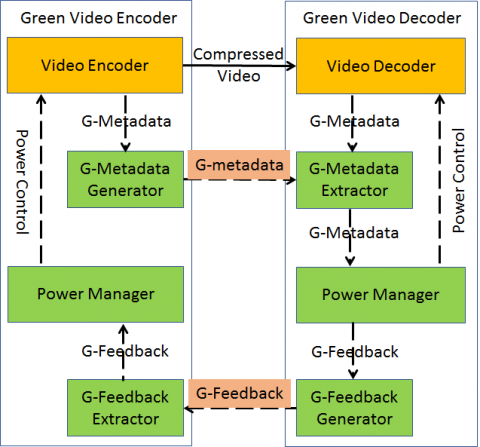
by Philip Merrill, March 2019
The principles of electrical circuits, such as current and voltage, have been used to support digital transmission of audio and video at varying bitrates over the internet. With Green MPEG it is possible to modulate that support in order to reduce power consumption to the right size needed for tasks such as processing or displaying video.
As machines for forming different configurations of electrical circuits, many times a second, computers and mobile phones require enough voltage and current for each task to be completed. For MPEG traditionally, the demands of bit-size and processing were considered as well as the advantages of using algorithms that could be embedded in the design of fixed-use circuitry. These latter require less power because the calculation is accomplished by pushing the charge through the circuit rather than performing random-access memory calculations. However far the logical distances that must be traveled in a split second, our machines can go to the limits we design. Energy saving introduces a new perspective.
If we ask ourselves how quickly how much data can be transmitted and we ensure that processing requirements can be supported, one option becomes the MPEG DASH approach which reduces the load based on the activities at the receiver. If you don't need all that data for a satisfactory streaming movie or other media, the data can be reduced to an appropriate level for the user's quality of experience. One way to think of Green MPEG is that it takes the same approach to power requirements that DASH takes to transmitting digital media information.
Because processing downloaded data and rendering it on a display consume the most power, these have been addressed by Green MPEG's metadata approach. The processing stage is addressed, for example, by informing the receiving device about the amount of several different types of algorithmic unpacking that are loaded on board the data (intra- & inter-prediction and the complexity of DCT & deblocking). This can be done with just a few bytes of description. From this description, the receiving device can then predict the exact energy consumed by the decoding process and adjust its processors in the right power state adequately in order to reduce the average energy consumption.
Reducing power consumption on the display side can be configured by boosting the gamma in the picture information and then dialing back the amount of brightness supplied to illuminate it. While this is not ideal in principle, its final results can be perceptually identical, which is reasonably ideal in practice. Someone with a 10% battery remaining could benefit by this approach, being able to nurse and stretch their remaining power to consume media for longer, before the inevitable recharge becomes mandatory.
Done delicately, changing what information is being processed based on its metadata can maintain high quality user experience while saving about 30% of power consumption. For reduced quality of experience, when a battery is really almost out of power, savings of 80% can be achieved, with managed degradation of the impaired experience. The power-management formulas to be used are not specified and provide an arena for competition between design engineers, their firms and their products.
In practice, Green MPEG Metadata are part of MPEG-B Systems Technologies. Metadata, which describe the video stream with various possible levels of granularity, are delivered in a specific message within the compressed stream, being either MPEG4-AVC or MPEG-H HEVC. Metadata, which assist the rendering process in the display, are delivered within MPEG-2 Transport Stream or Metadata tracks of ISO Base Media File Format, depending on applications.
The metadata are specified, hence standardized and normative, but the power managers at Green Video Encoders and Decoders can be performed by competing designs. Conformant bitstreams and reference software are now available from MPEG to provide a starting point.
With support for a wide range of use cases, the alternative signalling paths are many, stored, streamed, actual DASH, green feedback, etc. Thanks to Green MPEG Metadata, actual MPEG DASH for energy conservation adds another dimension to the bits and pieces DASH content is stored in on servers, so it is a logically more-simple example, changing what is supplied based on green performance feedback from the user device. Green MPEG Metadata help in producing the best quality of experience in energy-constrained environments.
The complexity information that lets power managers adjust the right level of instantaneous power is bound to become something of an art in itself — an art that further reduces the carbon footprint of all this energetic computing, for example, the growth of mobile streaming video.
